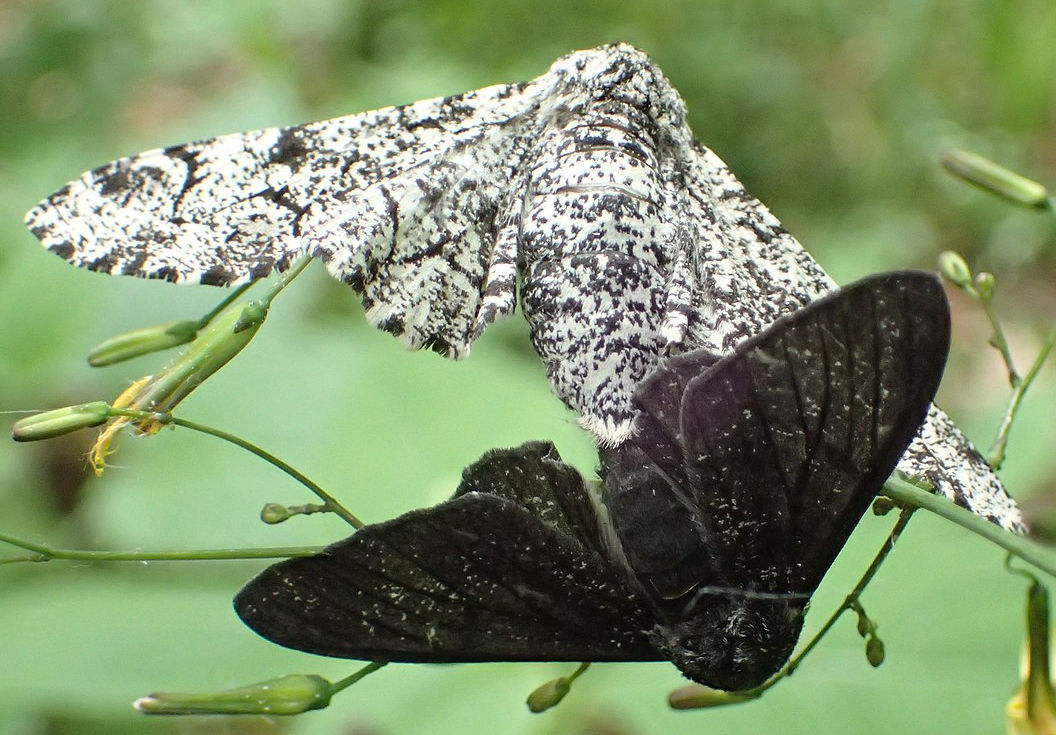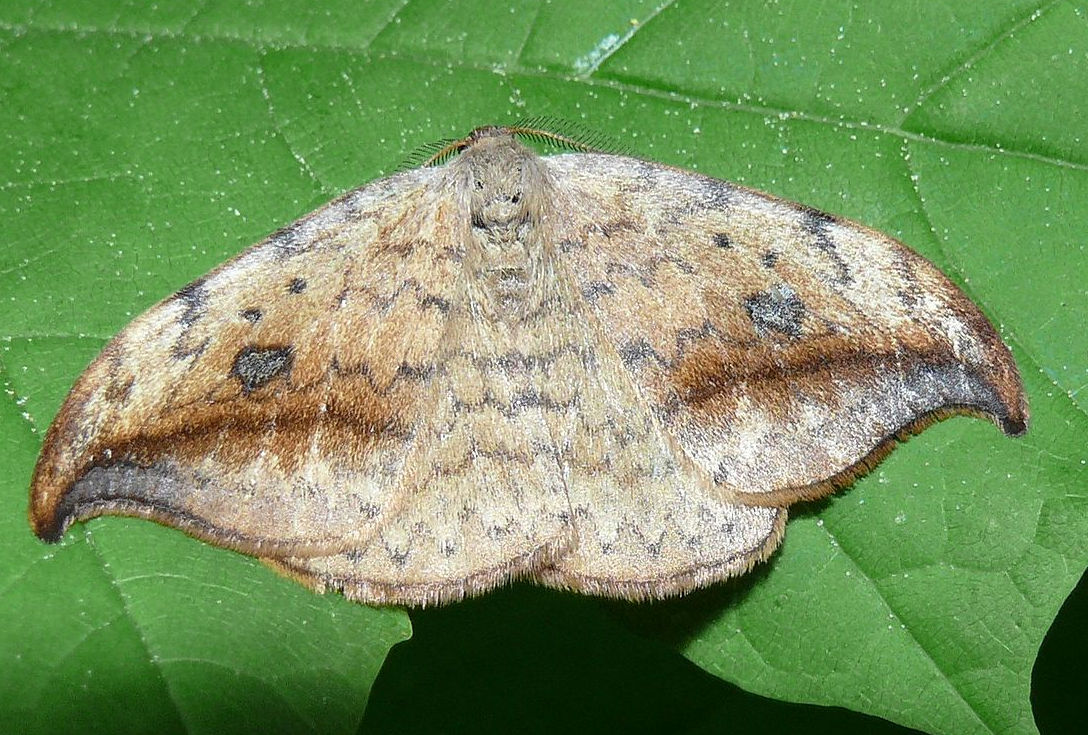Introduction to moths
By Steve Head
Most moths are active after dark and so go unseen unless attracted to a bright light. It is often the caterpillar stage that is more readily seen on plants during the day. Adult moths are best studied by running a light trap which can harmlessly trap a remarable number and variety of moths
"Moths" isn't a proper biological grouping or clade, unless you include the families we call butterflies within them. Globally there are about 186,000 lepidoptera species, of which about 10% are butterflies and the rest moths.
In Britain and Ireland we have about 2,500 moth species, of which Jennifer Owen recorded 375 species in her Leicester garden.
This (unlike the butterfles) is far too many to cover in detail here, and there are excellent websites that provide full information. We are only able to give an introduction to the main families, plus some pages on moths with particular behaviour or feeding habits. Unless you run a light trap or leave your windows open at night with the light on, larvae may be the most obvious part of moth lifecycles in the garden.
Main moth families found in gardens
The swift and ghost moths which we cover here.
This family includes the "hook-tips" and various others, some of which are dramatically marked. Jennifer Owen recorded ony 5 species, the common figure-of-eighty Tethyea ocularis and buff arches Habrosyne pyritoides, and uncommonly, the oak hook-tip Drepana binaria, pebble hook-tip Drepana falcataria and Chinese character Cilix glaucata.
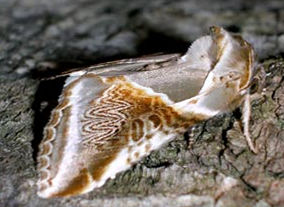
.jpg)
![Winter moth Operophtera brumata Photo: by Rob Mitchell [CC0] Wikimedia Commons](images/954px-Winter_Moth_(31482464863).jpg)
From left: Garden carpet Xanthorhoe fluctuata, common pug Eupithecia vulgata, Male winter moth Operophtera brumata and peppered moth Biston betularia
The winter moth's larvae are important early spring food for nestlings, and the moth is unusual because the female is flightless with vestigial wings. The peppered moth is one of the bulkiest geometers, and a classic evolution example. The normal form is "peppered" with black spots, which is good camouflage against bark, but the black "var carbonaria" became 98% dominant in populations near cities by 1895, being much better camouflaged against sooty tree trunks. With cleaner air, var carbonaria is once again scarce in Britain and Ireland.
The hawk-moths include our biggest and most spectacular moths. Of the 15 or so found in Britain and Ireland, Jennifer Owen found 5 in her garden, in decreasing order of abundance the lime hawk-moth Mimas tiliae, the poplar hawk-moth Laothoe populi, the eyed hawk-moth Smerinthus ocellata, the elephant hawk-moth Deilephila elpenor and the humming-bird hawk-moth Macroglossum stellatarum. Hawk-moths are strong flyers and have long wings which they hold in a "V" form when resting.
From left: Buff arches Habrosyne pyritoides, pebble hook tip Drepana falcataria and Chinese Character Cilix glaucata
This is a big family with 314 UK species, of which Jennifer Owen found 77 in her garden. The common name for their caterpillars is "inchworm" because they move with a vertical looping gait. See our page on moths with solitary caterpillars
Most geometers are relatively small and delicate, such as the many "pugs" and "carpets". They rest with wings oustretched to either side.
.jpg)
From left: lime hawk-moth Mimas tiliae, poplar hawk-moth Laothoe populi, eyed hawk-moth Smerinthus ocellata, elephant hawk-moth Deilephila elpenor. The eyed hawk-moth flashes its hind wings if disturbed, creating a startling owl-face which puts-off predators.
Modern genetic-based taxonomy has grouped a number of once familiar families of moths within this superfamily, and juggled somewhat with their contents. There are some 70,000 of these "owlet" moths globally, the largest lepidopteran superfamily. We can list the main garden species under the families Notodontidae, Erebidae and Noctuidae,
This family includes the attractive "prominents" with oddly shaped wings, the "kitten" moths and some characterful others. Jennifer Owen found 8 species in her garden, the most common being the swallow prominent Pheosia tremula and the pale prominent Pterostoma palpina.
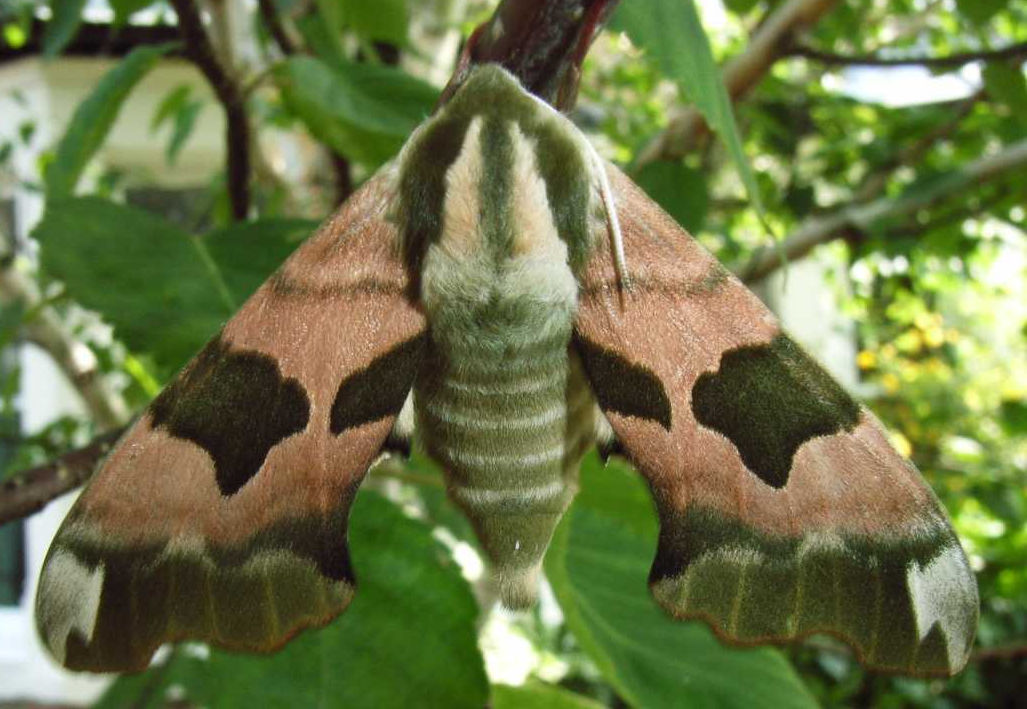
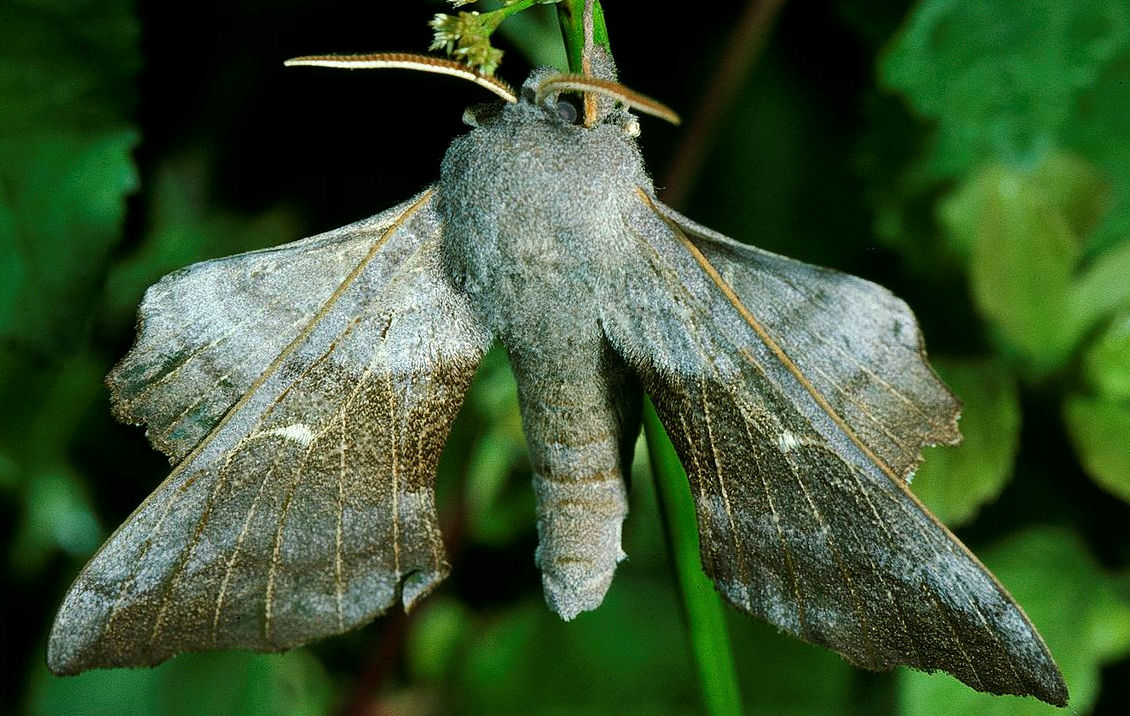
![Eyed Hawk-moth Smerinthus ocellata Photo: by Ben Sale from UK - [1980] , CC BY 2.0, https://commons.wikimedia.org/w/index.php?curid=63708247](images/1024px-(1980)_Eyed_Hawk-moth_(Smerinthus_ocellata)_(34889137122).jpg)
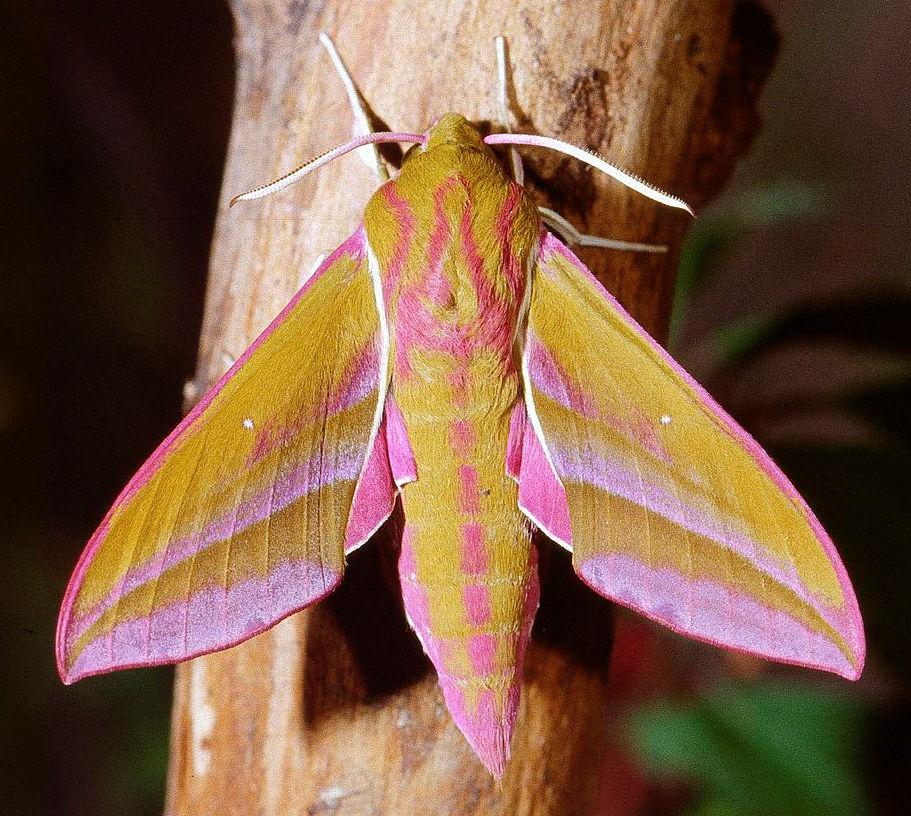
.jpg)
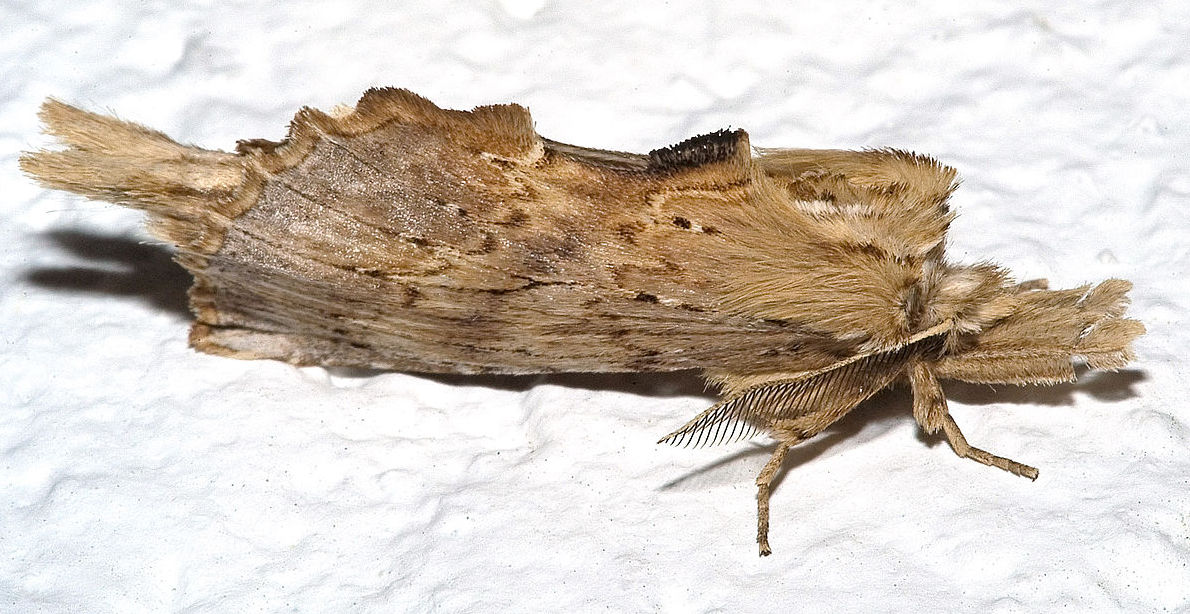
From left: Swallow prominent Pheosia tremula, pale prominent Pterostoma palpina and the Buff tip Phalera bucephala. The notodontids all tend to be cryptically or disruptively coloured, and the buff-tip remarkably mimics a broken twig.
This is one of the largest moth families and includes many sub-families once treated as at family level. It includes the tigers, ermines, footmen, snouts and tussocks among others. Jennifer Owen recorded 14 species in her garden. The commonest were the Vapourer Orgyia antiqua, yellow-tail Euproctis similis, common footman Eilema lurideola, garden tiger Arctia caja buff ermine Spilosoma luteum, snout moth Hypena proboscidalis and fan-foot Herminia tarsipennalis.
![Vapourer Orgyia antiqua Photo: by Ben Sale from UK - [2026] The , CC BY 2.0, https://commons.wikimedia.org/w/index.php?curid=63863523](images/800px-(2026)_The_Vapourer_(Orgyia_antiqua)_(36628738140).jpg)
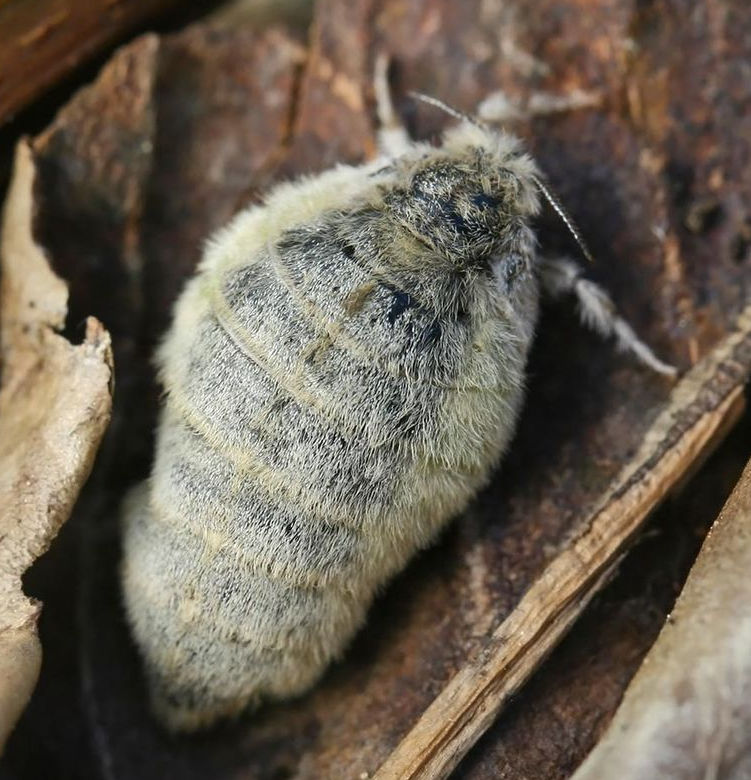
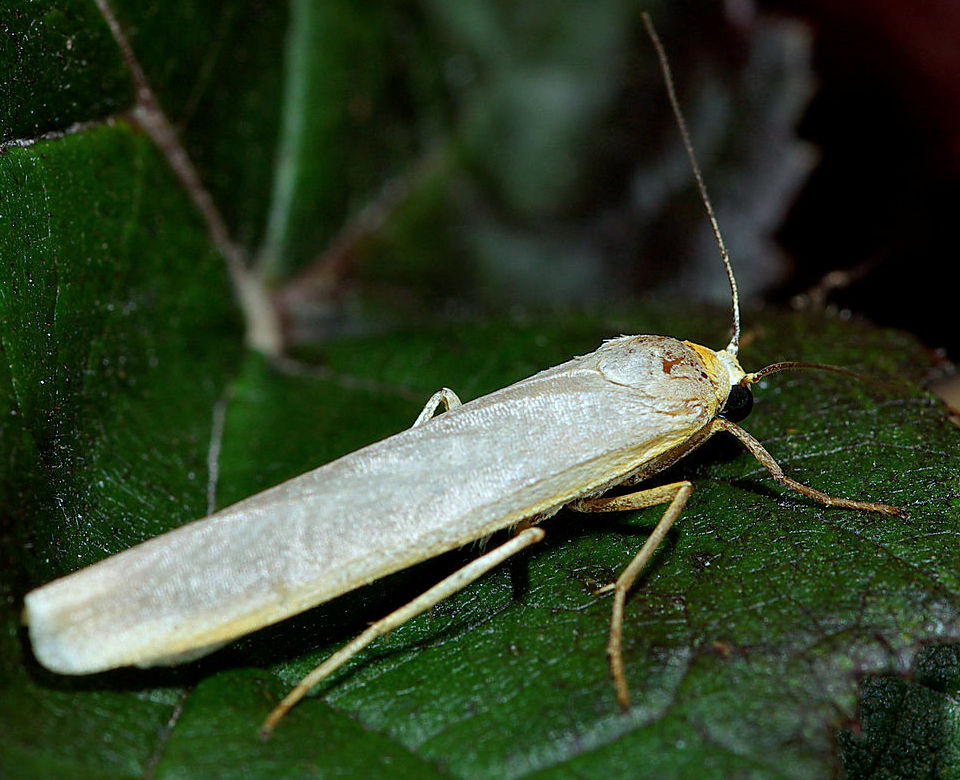
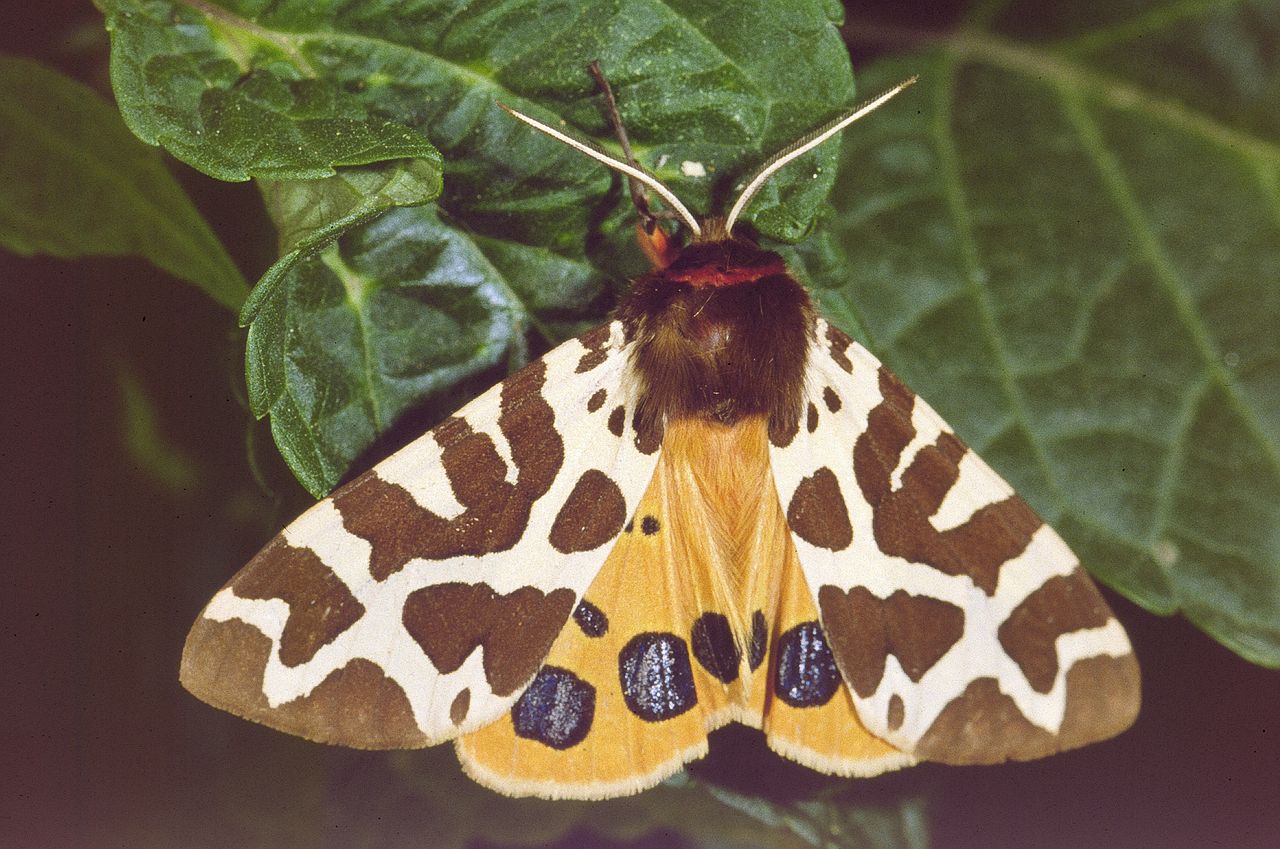
![Buff Ermine Spilosoma luteum Photo: by Ben Sale from UK - [2061], CC BY 2.0, https://commons.wikimedia.org/w/index.php?curid=63699814](images/(2061)_Buff_Ermine_(Spilosoma_luteum)_(4628877023).jpg)
.jpg)
From left: Vapourer Orgyia antiqua male and wingless female, common footman Eilema lurideola, and snout moth Hypena proboscidalis
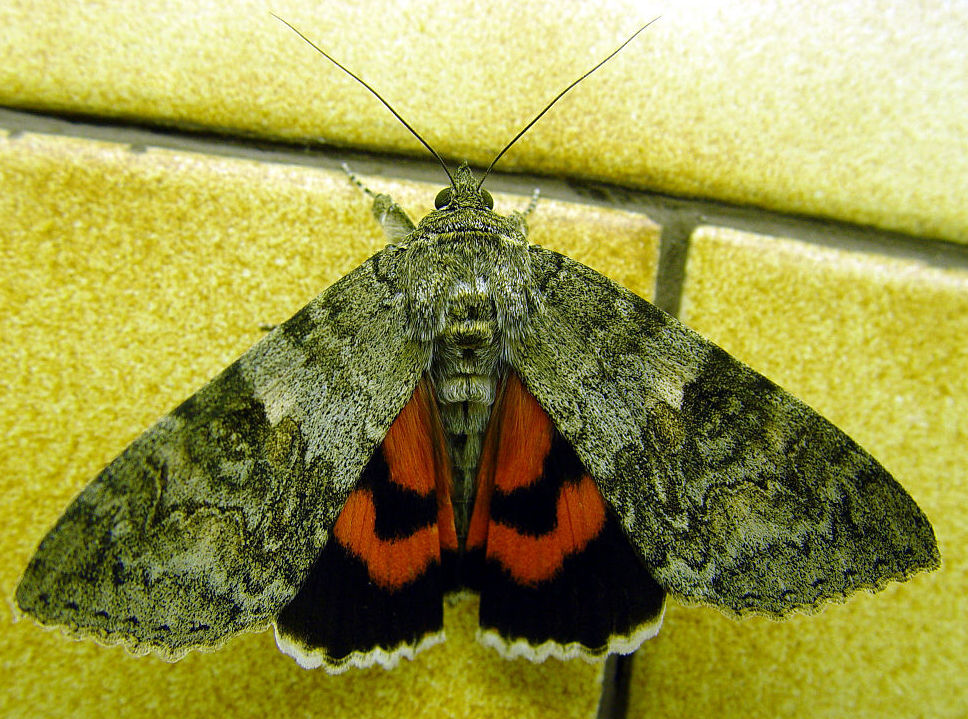
From left: Garden tiger Arctia caja - declining in the south of its range. Centre: buff ermine Spilosoma luteum Right: red underwing Catocala nupta, uncommon but very large and spectacular.
This is another very large family, with about 368 species in Britain and Ireland of which Jennifer Owen recorded 113.
Noctuids tend to be medium sized, chunky moths, and while many are drab and cryptic , some are very colourful. The group contains the yellow underwings, the darts, drabs, rustics among many others. Many are extremely abundant, either as residents or regular migrants.
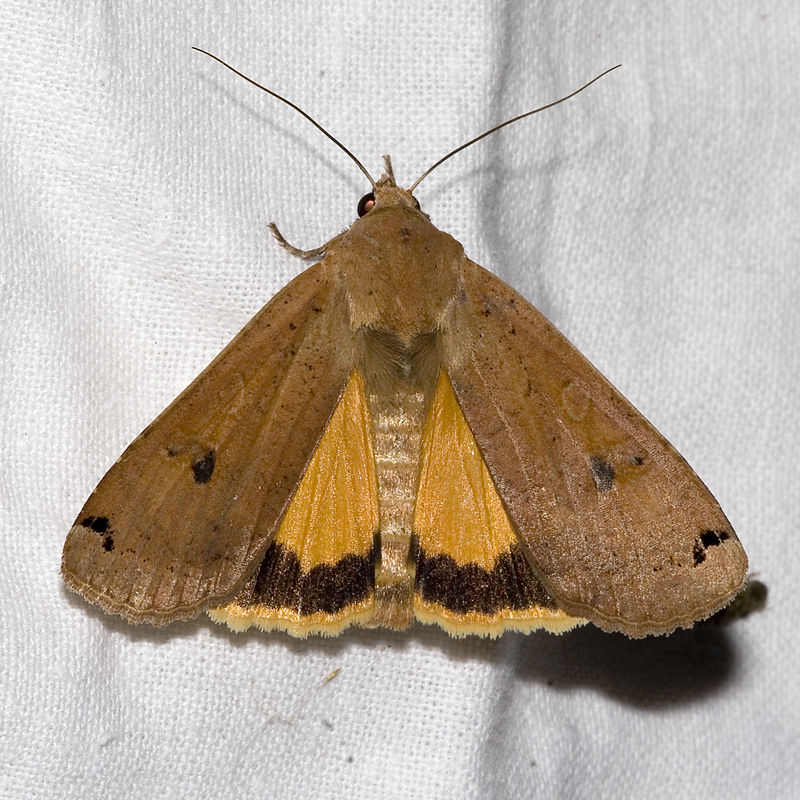
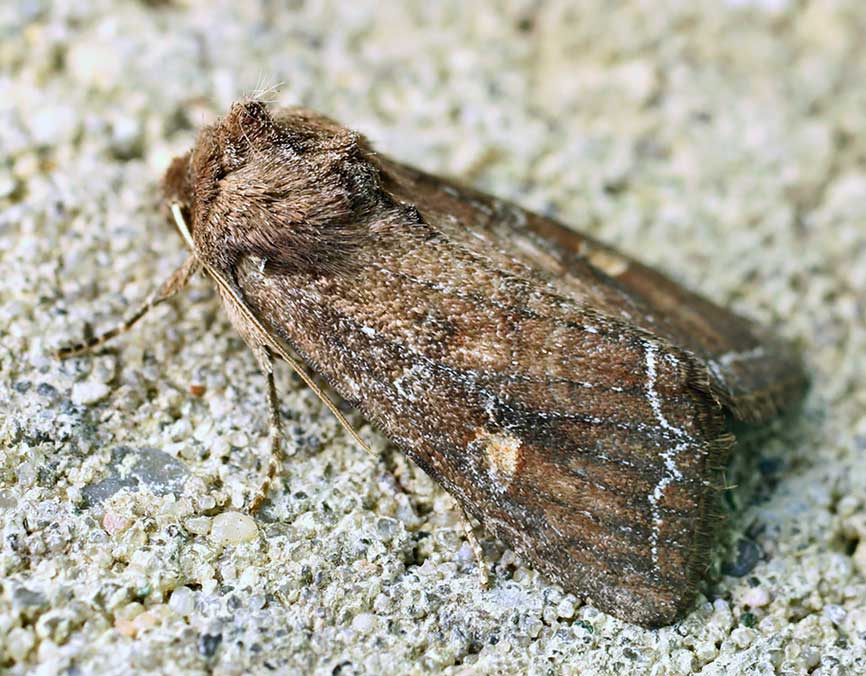
Angle_Shades._Phlogophora_meticulosa_-_Flickr_-_gailhampshire.jpg)
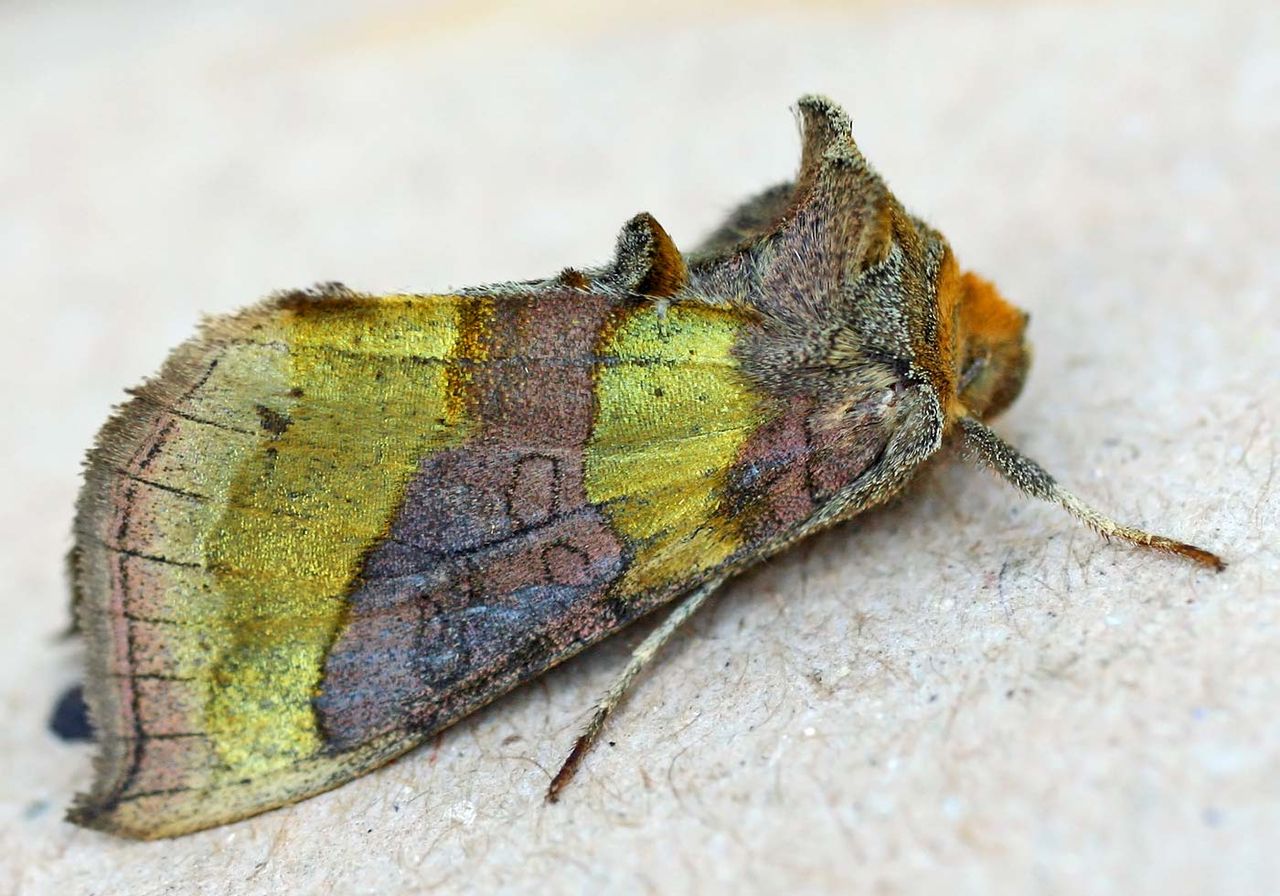
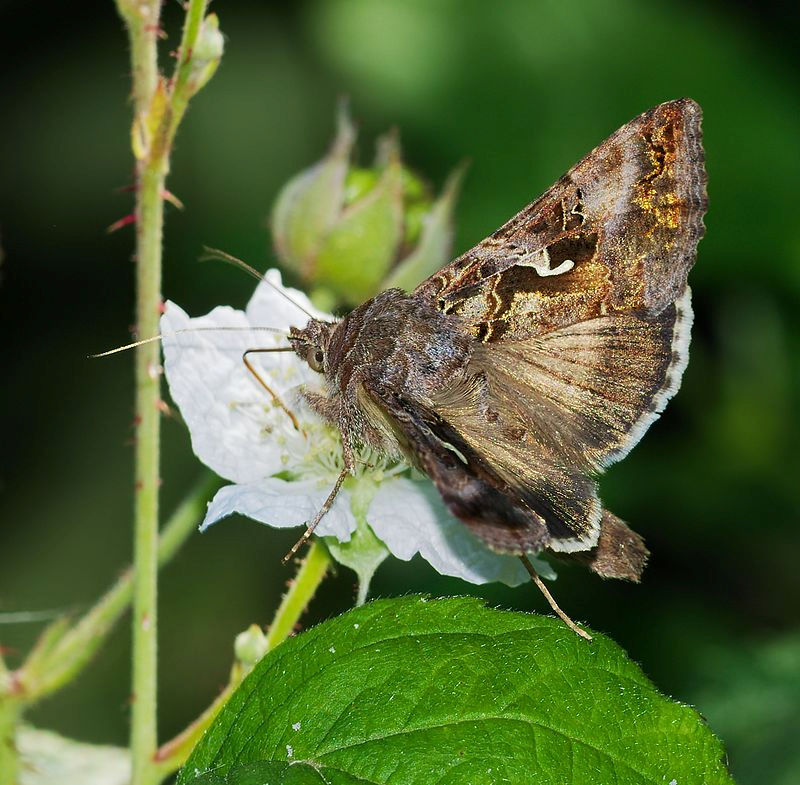
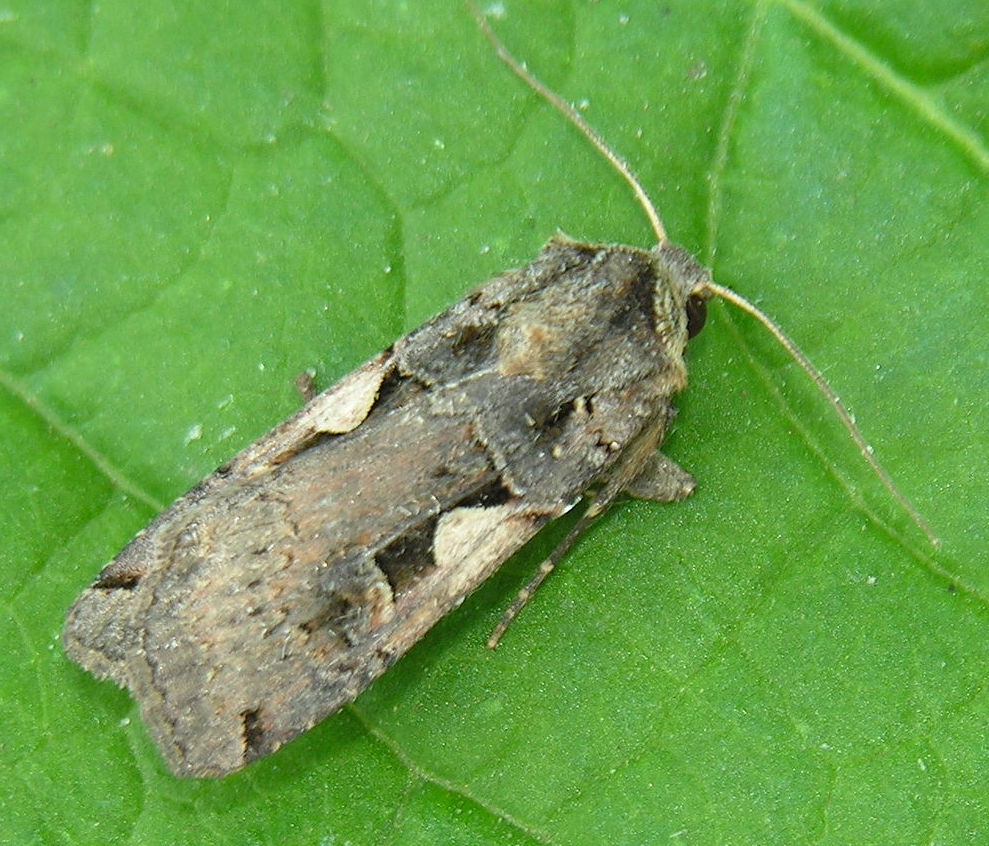
From left: Large yellow underwing Noctua pronuba , bright-line brown-eye Lacanobia oleracea, Angle Shades Phlogophora meticulosa
"Micro-moths"
The micromoths belong to families that didn't get into Richard South's two volume "Moths of the British Isles" first published in 1907 and regarded as definitive until quite recently. The ones that did get in such as the groups discussed above are still considered "macro-moths". Needless to say, some "micros" are larger than some "macros".
There are over 1,600 species of micro-moths in Britain and Ireland, compared with only 800 macro-moths, in at least 45 families. Jennifer Owen recorded 91 species in her garden, mostly in small numbers. We have space only to illustrate some of the species she found to be abundant or common. Even some of the abundant species are poorly enough known to have no common English name.
It would be a good challenge for a keen garden insect collector to study their micro-moths. Jennifer Owen found that one of her captures was only the second British record for the species.
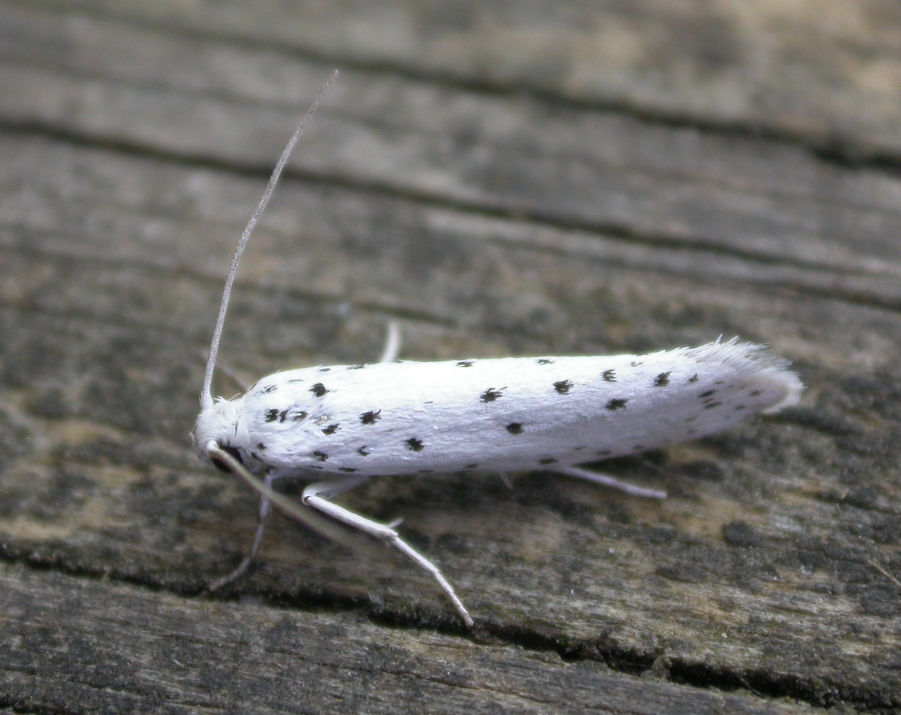
![Carcina quercana Photo: by Ben Sale from UK - [0658] CC BY 2.0, https://commons.wikimedia.org/w/index.php?curid=45325877](images/(0658)_Carcina_quercana_(15156545530).jpg)
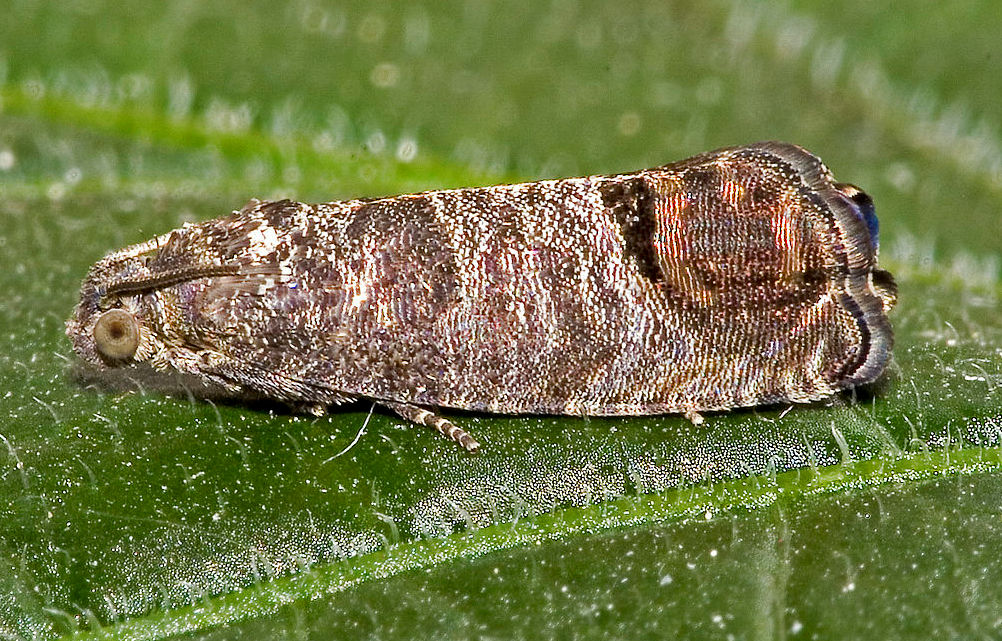
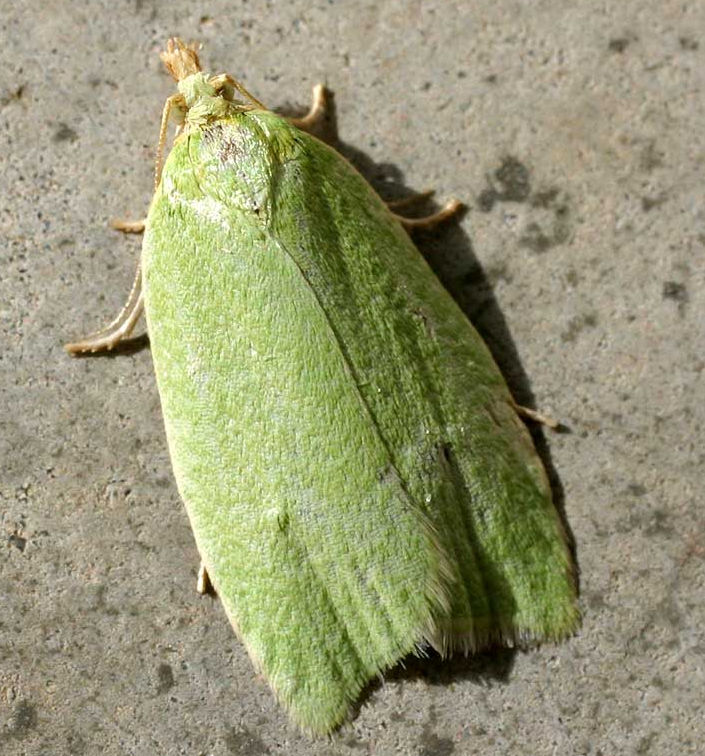
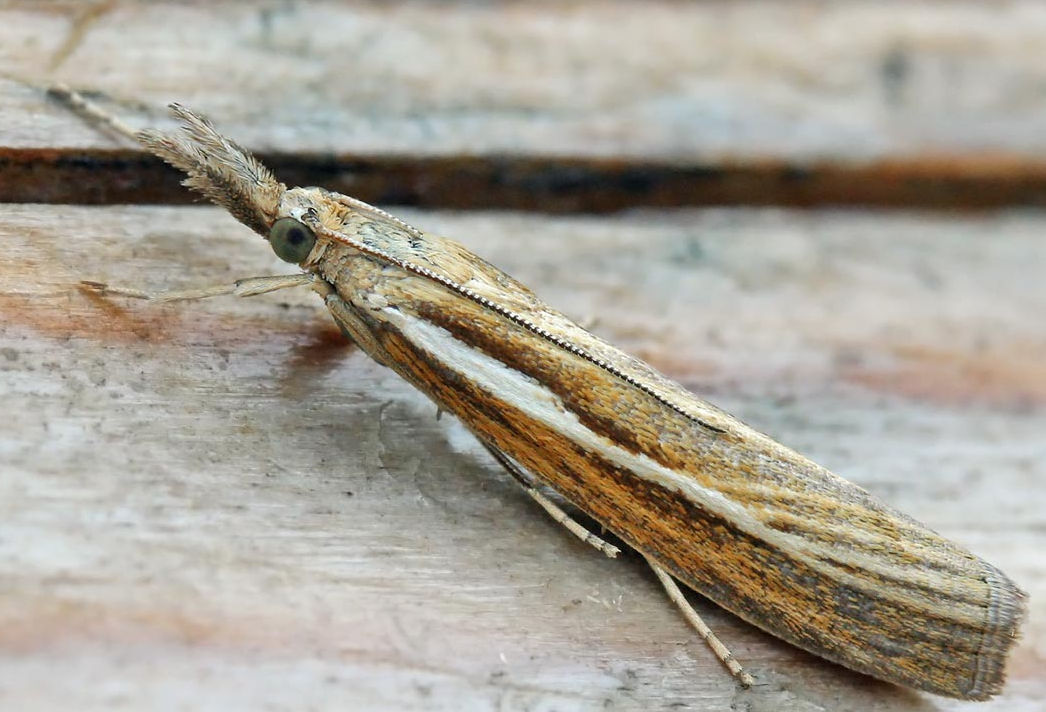
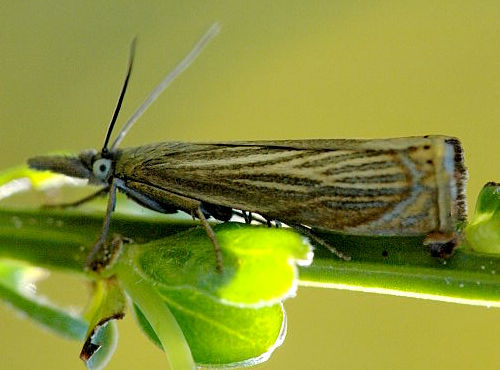
.jpg)
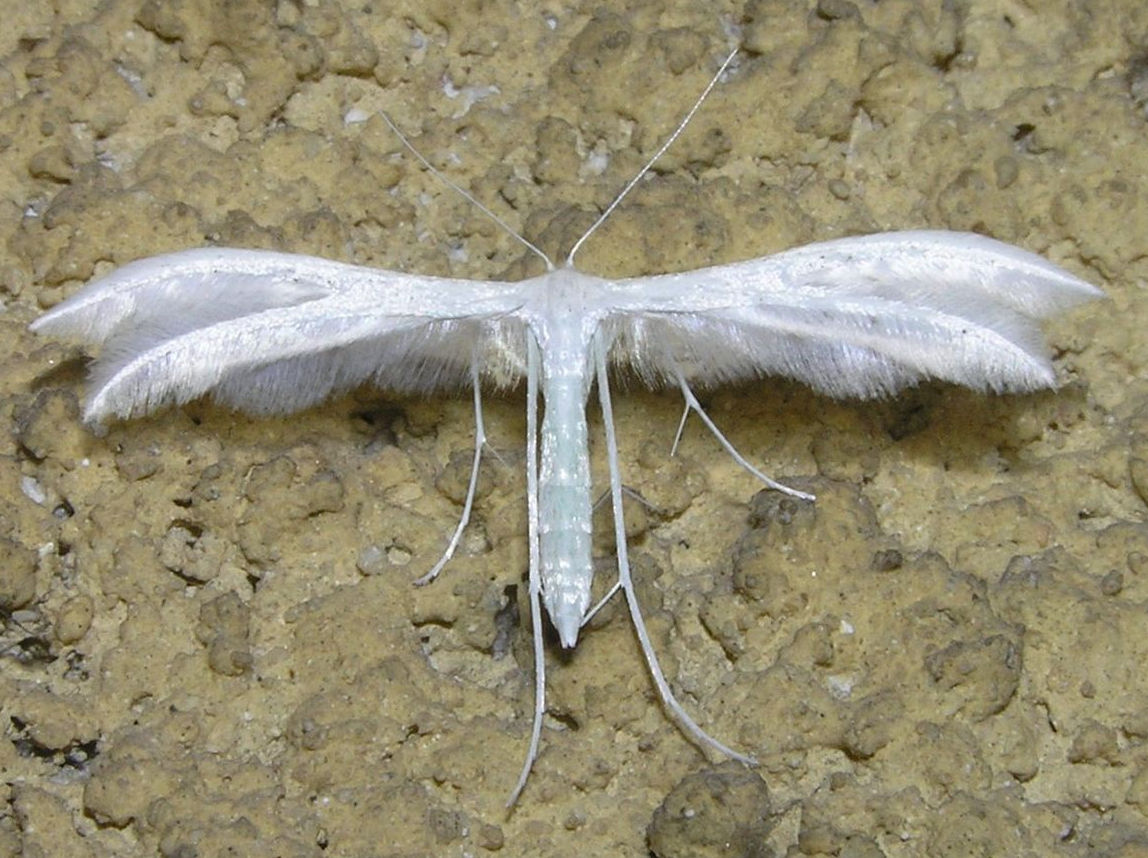
From left: Spindle ermine Yponomeuta cagnagella (family Yponomeutidae), Carcina quercana (family Oecophoridae), Codling moth Cydea pommonella (family Tortricidae) - pest on apple trees, Green oak tortrix Tortrix viridana (familyTortricidae)
From left: White plume moth Pterophorus pentadactyla (family Pterophoridae), three species in the family Pyralidae
Agriphila tristella, Chrysoteuchia culmella (both abundant), small magpie Eurrhypara hortulata.
Other moth families
You can find examples of some lesser families in our specialist pages:
Biology
Most moth larvae feed on plant foliage but sometimes eat other parts, such as flower buds, as well. During the day caterpillars often hide out of sight and most of their feeding is done at night. Some caterpillars, however, such as those of the mullein moth Cucullia verbasci (left: below), feed openly during the day. Their yellow and black markings are likely to be warning colouration to indicate to birds that they taste unpleasant. Similar warning colours can be seen on cinnabar moth larvae, Tyria jacobaeae (below right), which feed on ragwort.
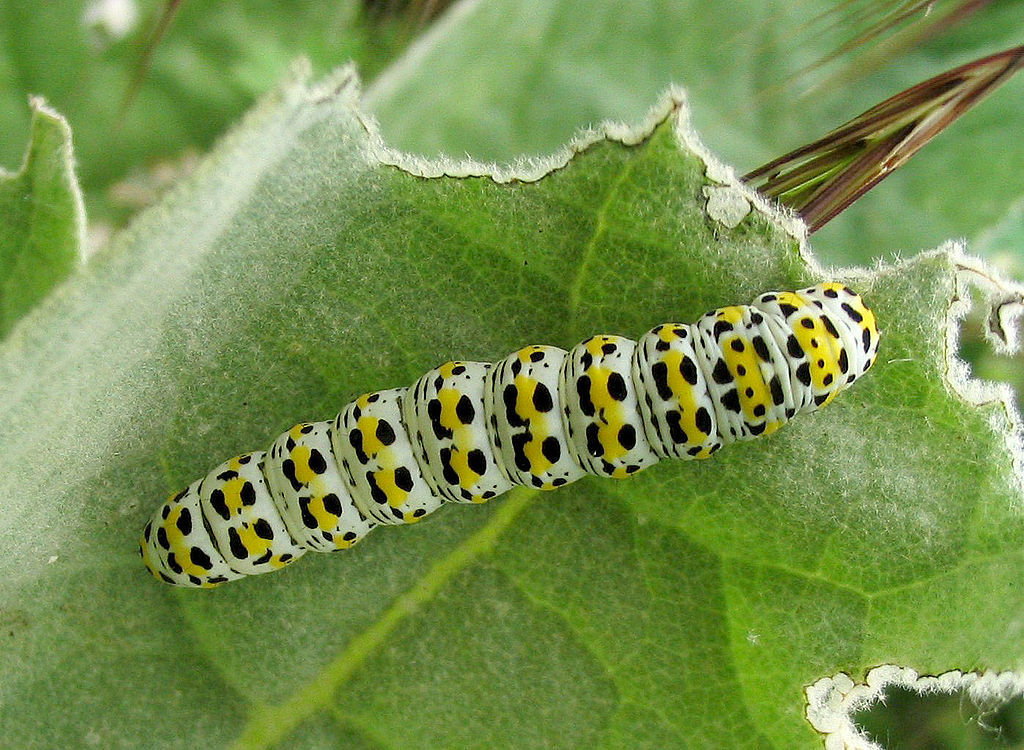
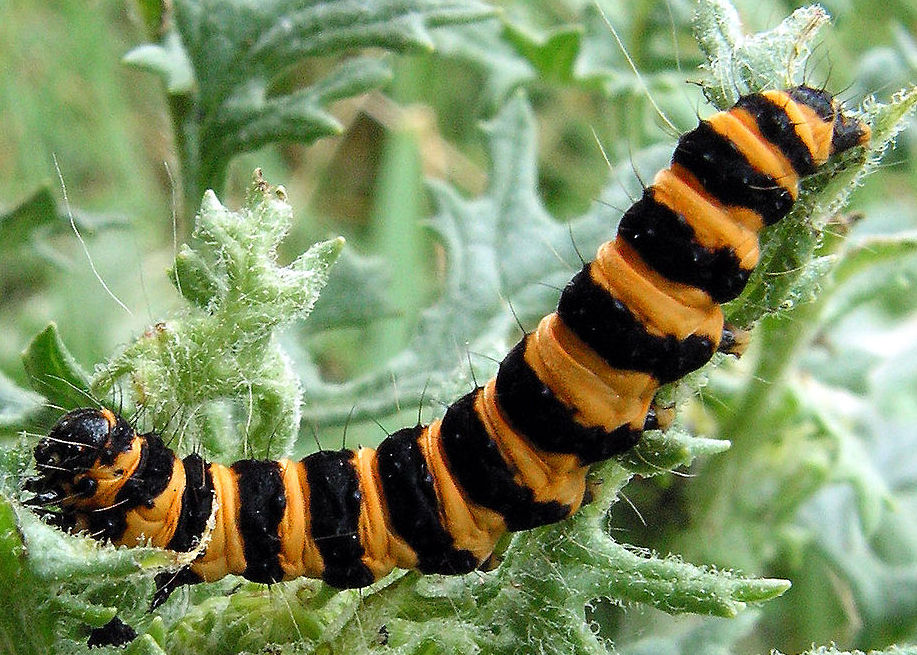
Some moths, such as winter moth, mottled umber moth, Erannis defoliaria and March moth, Alsophila aescularia, emerge as adults in the colder months of the year. These moths have fully winged males but the females have vestigial wings that are reduced to small stubs and cannot fly.
Life cycle
Most moths lay their eggs in batches on suitable food plants for their caterpillar larvae. After hatching, some caterpillars stick together (see our page on gregarious larvae), but most disperse and lead solitary lives.
The caterpillars will shed their outer skins on several occasions as they develop and increase in size. When fully fed, the caterpillars wander away from their food plants and often burrow into the soil where they will pupate. During the pupal stage, the caterpillar’s tissues are broken down and rebuilt to produce the adult moth. Some moths have more than one generation a year. Depending on the species, moths can overwinter as adults, eggs, larvae or pupae. Most moth pupae are hidden in the soil, although some, such as the puss moth Cerura vinula and the burnet moths construct silken cocoons on twigs or grass stems.
Role of moths in gardens
Adult moths cause no damage to plants as their feeding is restricted to taking nectar from flowers. Only a small minority of moths have larvae that cause sufficient damage to garden plants to be considered pests. The rest have little or no impact on cultivated plants. Some adult moths visit flowers to feed on nectar. While doing so they can pick up pollen on their bodies and assist in the pollination process.
The largely nocturnal activity of adult moths means they are important prey items for bats and nightjars. The caterpillars of moths are often heavily predated by birds and various parasitic insects. The breeding success of birds such as the blue tit and great tit1, is related to the availability of caterpillars during the birds’ breeding season.
Other sources of information
Reference
1. Naef-Daenzer, Luzia & Naef-Daenzer, Beat & G. Nager, Ruedi. (2000). Prey selection and foraging performance of breeding Great Tits Parus major in relation to food availability. Journal of Avian Biology 31. 206-214.
Website
Butterfly Conservation's Moth Website
Website of UK Moths
Garden Moth Scheme website
OPAL moth tips 1 - getting started in garden moth trapping (Books and moth traps)
OPAL moth tips 2 - introduction to the families of British and Irish macro-moths
OPAL moth tips 3 - introduction to the families of British and Irish micro-moths
Books
Goater B., Senior G. and Dyke R. (1986) British Pyralid Moths: a Guide to their Identification. Harley Books
James, D.G. (2017) The Book of Caterpillars. Ivy Press (Not for identification use! International in scope, but a fascinating and well illustrated compendium of caterpillar diversity)
Porter, J. (2010) Colour Identification Guide to the Caterpillars of the British Isles. Apollo Books
Skinner, B. (2009) Colour Identification Guide to the Moths of the British Isles. Apollo Books
Sterling, P., Parsons, M. and Lewington R. (2018) Field Guide to the Micro-moths of Great Britain and Ireland. British Wildlife Publications
Sterling, P., Henwood, B., Lewington, R. (2020) Field Guide to the Caterpillars of Great Britain and Ireland
Bloomsbury Wildlife Guides
Townsend, M. Waring, P. and Lewington R. (2018) Concise Guide to the Moths of Great Britain and Ireland. British Wildlife Publication
Randle, Zoe et al 2019 Atlas of Britain and Irelands's Larger Moths. Nature Bureau
Page drafted and compiled by Steve Head
Introduction to moths
By Steve Head
Most moths are active after dark and so go unseen unless attracted to a bright light. It is often the caterpillar stage that is more readily seen on plants during the day. Adult moths are best studied by running a light trap which can harmlessly trap a remarable number and variety of moths
"Moths" isn't a proper biological grouping or clade, unless you include the families we call butterflies within them. Globally there are about 186,000 lepidoptera species, of which about 10% are butterflies and the rest moths.
In Britain and Ireland we have about 2,500 moth species, of which Jennifer Owen recorded 375 species in her Leicester garden.
This (unlike the butterfles) is far too many to cover in detail here, and there are excellent websites that provide full information. We are only able to give an introduction to the main families, plus some pages on moths with particular behaviour or feeding habits. Unless you run a light trap or leave your windows open at night with the light on, larvae may be the most obvious part of moth lifecycles in the garden.
Main moth families found in gardens
The swift and ghost moths which we cover here.
This family includes the "hook-tips" and various others, some of which are dramatically marked. Jennifer Owen recorded ony 5 species, the common figure-of-eighty Tethyea ocularis and buff arches Habrosyne pyritoides, and uncommonly, the oak hook-tip Drepana binaria, pebble hook-tip Drepana falcataria and Chinese character Cilix glaucata.
Introduction to moths
By Steve Head
Most moths are active after dark and so go unseen unless attracted to a bright light. It is often the caterpillar stage that is more readily seen on plants during the day. Adult moths are best studied by running a light trap which can harmlessly trap a remarable number and variety of moths
"Moths" isn't a proper biological grouping or clade, unless you include the families we call butterflies within them. Globally there are about 186,000 lepidoptera species, of which about 10% are butterflies and the rest moths.
In Britain and Ireland we have about 2,500 moth species, of which Jennifer Owen recorded 375 species in her Leicester garden.
This (unlike the butterfles) is far too many to cover in detail here, and there are excellent websites that provide full information. We are only able to give an introduction to the main families, plus some pages on moths with particular behaviour or feeding habits. Unless you run a light trap or leave your windows open at night with the light on, larvae may be the most obvious part of moth lifecycles in the garden.
Main moth families found in gardens
The swift and ghost moths which we cover here.
This family includes the "hook-tips" and various others, some of which are dramatically marked. Jennifer Owen recorded ony 5 species, the common figure-of-eighty Tethyea ocularis and buff arches Habrosyne pyritoides, and uncommonly, the oak hook-tip Drepana binaria, pebble hook-tip Drepana falcataria and Chinese character Cilix glaucata.
Introduction to moths
By Steve Head
Most moths are active after dark and so go unseen unless attracted to a bright light. It is often the caterpillar stage that is more readily seen on plants during the day. Adult moths are best studied by running a light trap which can harmlessly trap a remarable number and variety of moths
"Moths" isn't a proper biological grouping or clade, unless you include the families we call butterflies within them. Globally there are about 186,000 lepidoptera species, of which about 10% are butterflies and the rest moths.
In Britain and Ireland we have about 2,500 moth species, of which Jennifer Owen recorded 375 species in her Leicester garden.
This (unlike the butterfles) is far too many to cover in detail here, and there are excellent websites that provide full information. We are only able to give an introduction to the main families, plus some pages on moths with particular behaviour or feeding habits. Unless you run a light trap or leave your windows open at night with the light on, larvae may be the most obvious part of moth lifecycles in the garden.
Main moth families found in gardens
The swift and ghost moths which we cover here.
This family includes the "hook-tips" and various others, some of which are dramatically marked. Jennifer Owen recorded ony 5 species, the common figure-of-eighty Tethyea ocularis and buff arches Habrosyne pyritoides, and uncommonly, the oak hook-tip Drepana binaria, pebble hook-tip Drepana falcataria and Chinese character Cilix glaucata.
Introduction to moths
Most moths are active after dark and so go unseen unless attracted to a bright light. It is often the caterpillar stage that is more readily seen on plants during the day. Adult moths are best studied by running a light trap which can harmlessly trap a remarable number and variety of moths
"Moths" isn't a proper biological grouping or clade, unless you include the families we call butterflies within them. Globally there are about 186,000 lepidoptera species, of which about 10% are butterflies and the rest moths.
In Britain and Ireland we have about 2,500 moth species, of which Jennifer Owen recorded 375 species in her Leicester garden.
This (unlike the butterfles) is far too many to cover in detail here, and there are excellent websites that provide full information. We are only able to give an introduction to the main families, plus some pages on moths with particular behaviour or feeding habits. Unless you run a light trap or leave your windows open at night with the light on, larvae may be the most obvious part of moth lifecycles in the garden.
Main moth families found in gardens
This family includes the "hook-tips" and various others, some of which are dramatically marked. Jennifer Owen recorded ony 5 species, the common figure-of-eighty Tethyea ocularis and buff arches Habrosyne pyritoides, and uncommonly, the oak hook-tip Drepana binaria, pebble hook-tip Drepana falcataria and Chinese character Cilix glaucata.

.jpg)
From left: Buff arches Habrosyne pyritoides, pebble hook tip Drepana falcataria and Chinese Character Cilix glaucata
This is a big family with 314 UK species, of which Jennifer Owen found 77 in her garden. The common name for their caterpillars is "inchworm" because they move with a vertical looping gait. See our page on moths with solitary caterpillars
Most geometers are relatively small and delicate, such as the many "pugs" and "carpets". They rest with wings oustretched to either side.
![Winter moth Operophtera brumata Photo: by Rob Mitchell [CC0] Wikimedia Commons](images/954px-Winter_Moth_(31482464863).jpg)
.jpg)
Left: Male winter moth Operophtera brumata Right: peppered moth Biston betularia
The winter moth's larvae are important early spring food for nestlings, and the moth is unusual because the female is flightless with vestigial wings. The peppered moth is one of the bulkiest geometers, and a classic evolution example. The normal form is "peppered" with black spots, which is good camouflage against bark, but the black "var carbonaria" became 98% dominant in populations near cities by 1895, being much better camouflaged against sooty tree trunks. With cleaner air, var carbonaria is once again scarce in Britain and Ireland.
The hawk-moths include our biggest and most spectacular moths. Of the 15 or so found in Britain and Ireland, Jennifer Owen found 5 in her garden, in decreasing order of abundance the lime hawk-moth Mimas tiliae, the poplar hawk-moth Laothoe populi, the eyed hawk-moth Smerinthus ocellata, the elephant hawk-moth Deilephila elpenor and the humming-bird hawk-moth Macroglossum stellatarum. Hawk-moths are strong flyers and have long wings which they hold in a "V" form when resting.
Left:Garden carpet Xanthorhoe fluctuata, Right: common pug Eupithecia vulgata,

![Eyed Hawk-moth Smerinthus ocellata Photo: by Ben Sale from UK - [1980] , CC BY 2.0, https://commons.wikimedia.org/w/index.php?curid=63708247](images/1024px-(1980)_Eyed_Hawk-moth_(Smerinthus_ocellata)_(34889137122).jpg)
Modern genetic-based taxonomy has grouped a number of once familiar families of moths within this superfamily, and juggled somewhat with their contents. There are some 70,000 of these "owlet" moths globally, the largest lepidopteran superfamily. We can list the main garden species under the families Notodontidae, Erebidae and Noctuidae,
This family includes the attractive "prominents" with oddly shaped wings, the "kitten" moths and some characterful others. Jennifer Owen found 8 species in her garden, the most common being the swallow prominent Pheosia tremula and the pale prominent Pterostoma palpina.


Above left: lime hawk-moth Mimas tiliae, Right: poplar hawk-moth Laothoe populi
Below left: eyed hawk-moth Smerinthus ocellata, Right: elephant hawk-moth Deilephila elpenor. The eyed hawk-moth flashes its hind wings if disturbed, creating a stratling owl-face which puts-off predators.
.jpg)

This is one of the largest moth families and includes many sub-families once treated as at family level. It includes the tigers, ermines, footmen, snouts and tussocks among others. Jennifer Owen recorded 14 species in her garden. The commonest were the Vapourer Orgyia antiqua, yellow-tail Euproctis similis, common footman Eilema lurideola, garden tiger Arctia caja buff ermine Spilosoma luteum, snout moth Hypena proboscidalis and fan-foot Herminia tarsipennalis.
Top left: Swallow prominent Pheosia tremula, Top right: pale prominent Pterostoma palpina, Left: Buff tip Phalera bucephala. The notodontids all tend to be cryptically or disruptively coloured, and the buff-tip remarkably mimics a broken twig.
.jpg)


Above left: Vapourer Orgyia antiqua male and wingless female
Below Left:common footman Eilema lurideola Right: snout moth Hypena proboscidalis
![Vapourer Orgyia antiqua Photo: by Ben Sale from UK - [2026] The , CC BY 2.0, https://commons.wikimedia.org/w/index.php?curid=63863523](images/800px-(2026)_The_Vapourer_(Orgyia_antiqua)_(36628738140).jpg)

![Buff Ermine Spilosoma luteum Photo: by Ben Sale from UK - [2061], CC BY 2.0, https://commons.wikimedia.org/w/index.php?curid=63699814](images/(2061)_Buff_Ermine_(Spilosoma_luteum)_(4628877023).jpg)
This is another very large family, with about 368 species in Britain and Ireland of which Jennifer Owen recorded 113.
Noctuids tend to be medium sized, chunky moths, and while many are drab and cryptic , some are very colourful. The group contains the yellow underwings, the darts, drabs, rustics among many others. Many are extremely abundant, either as residents or regular migrants.
Above left: Garden tiger Arctia caja - declining in the south of its range. Right: buff ermine Spilosoma luteum
Left: red underwing Catocala nupta, uncommon but very large and spectacular.

Angle_Shades._Phlogophora_meticulosa_-_Flickr_-_gailhampshire.jpg)

Above left: Large yellow underwing Noctua pronuba Right: bright-line brown-eye Lacanobia oleracea
Below left: Angle Shades Phlogophora meticulosa Right: Burnished Brass Diachrysia chrysitis




Above Left: Silver Y Autographa gamma Right: Setaceous Hebrew Character Xestia c-nigrum.
"Micro-moths"
The micromoths belong to families that didn't get into Richard South's two volume "Moths of the British Isles" first published in 1907 and regarded as definitive until quite recently. The ones that did get in such as the groups discussed above are still considered "macro-moths". Needless to say, some "micros" are larger than some "macros".
There are over 1,600 species of micro-moths in Britain and Ireland, compared with only 800 macro-moths, in at least 45 families. Jennifer Owen recorded 91 species in her garden, mostly in small numbers. We have space only to illustrate some of the species she found to be abundant or common. Even some of the abundant species are poorly enough known to have no common English name.
It would be a good challenge for a keen garden insect collector to study their micro-moths. Jennifer Owen found that one of her captures was only the second British record for the species.

![Carcina quercana Photo: by Ben Sale from UK - [0658] CC BY 2.0, https://commons.wikimedia.org/w/index.php?curid=45325877](images/(0658)_Carcina_quercana_(15156545530).jpg)

Above left: Spindle ermine Yponomeuta cagnagella (family Yponomeutidae) Right Carcina quercana (family Oecophoridae)
Below Left: Codling moth Cydea pommonella (family Tortricidae) - pest on apple trees, Right Green oak tortrix Tortrix viridana (familyTortricidae)



.jpg)

Other moth families
You can find examples of some lesser families in our specialist pages:
Biology
Most moth larvae feed on plant foliage but sometimes eat other parts, such as flower buds, as well. During the day caterpillars often hide out of sight and most of their feeding is done at night. Some caterpillars, however, such as those of the mullein moth Cucullia verbasci (left: below), feed openly during the day. Their yellow and black markings are likely to be warning colouration to indicate to birds that they taste unpleasant. Similar warning colours can be seen on cinnabar moth larvae, Tyria jacobaeae (below right), which feed on ragwort.
Above left: White plume moth Pterophorus pentadactyla (family Pterophoridae) Right Agriphila tristella (family Pyralidae)- abundant
Below left: Chrysoteuchia culmella (abundant) Right: small magpie Eurrhypara hortulata. (both family Pyralidae)


Some moths, such as winter moth, mottled umber moth, Erannis defoliaria and March moth, Alsophila aescularia, emerge as adults in the colder months of the year. These moths have fully winged males but the females have vestigial wings that are reduced to small stubs and cannot fly.
Life cycle
Most moths lay their eggs in batches on suitable food plants for their caterpillar larvae. After hatching, some caterpillars stick together (see our page on gregarious larvae), but most disperse and lead solitary lives.
The caterpillars will shed their outer skins on several occasions as they develop and increase in size. When fully fed, the caterpillars wander away from their food plants and often burrow into the soil where they will pupate. During the pupal stage, the caterpillar’s tissues are broken down and rebuilt to produce the adult moth. Some moths have more than one generation a year. Depending on the species, moths can overwinter as adults, eggs, larvae or pupae. Most moth pupae are hidden in the soil, although some, such as the puss moth Cerura vinula and the burnet moths construct silken cocoons on twigs or grass stems.
Role of moths in gardens
Adult moths cause no damage to plants as their feeding is restricted to taking nectar from flowers. Only a small minority of moths have larvae that cause sufficient damage to garden plants to be considered pests. The rest have little or no impact on cultivated plants. Some adult moths visit flowers to feed on nectar. While doing so they can pick up pollen on their bodies and assist in the pollination process.
The largely nocturnal activity of adult moths means they are important prey items for bats and nightjars. The caterpillars of moths are often heavily predated by birds and various parasitic insects. The breeding success of birds such as the blue tit and great tit1, is related to the availability of caterpillars during the birds’ breeding season.
Other sources of information
Reference
1. Naef-Daenzer, Luzia & Naef-Daenzer, Beat & G. Nager, Ruedi. (2000). Prey selection and foraging performance of breeding Great Tits Parus major in relation to food availability. Journal of Avian Biology 31. 206-214.
Website
Butterfly Conservation's Moth Website
Website of UK Moths
Garden Moth Scheme website
Books
Goater B., Senior G. and Dyke R. (1986) British Pyralid Moths: a Guide to their Identification. Harley Books
James, D.G. (2017) The Book of Caterpillars. Ivy Press (Not for identification use! International in scope, but a fascinating and well illustrated compendium of caterpillar diversity)
Porter, J. (2010) Colour Identification Guide to the Caterpillars of the British Isles. Apollo Books
Skinner, B. (2009) Colour Identification Guide to the Moths of the British Isles. Apollo Books
Sterling, P., Parsons, M. and Lewington R. (2018) Field Guide to the Micro-moths of Great Britain and Ireland. British Wildlife Publications
Townsend, M. & Waring, P. and Lewington R. (2018) Concise Guide to the Moths of Great Britain and Ireland. British Wildlife Publication
Randle, Zoe et al 2019 Atlas of Britain and Irelands's Larger Moths. Nature Bureau
Page drafted and compiled by Steve Head
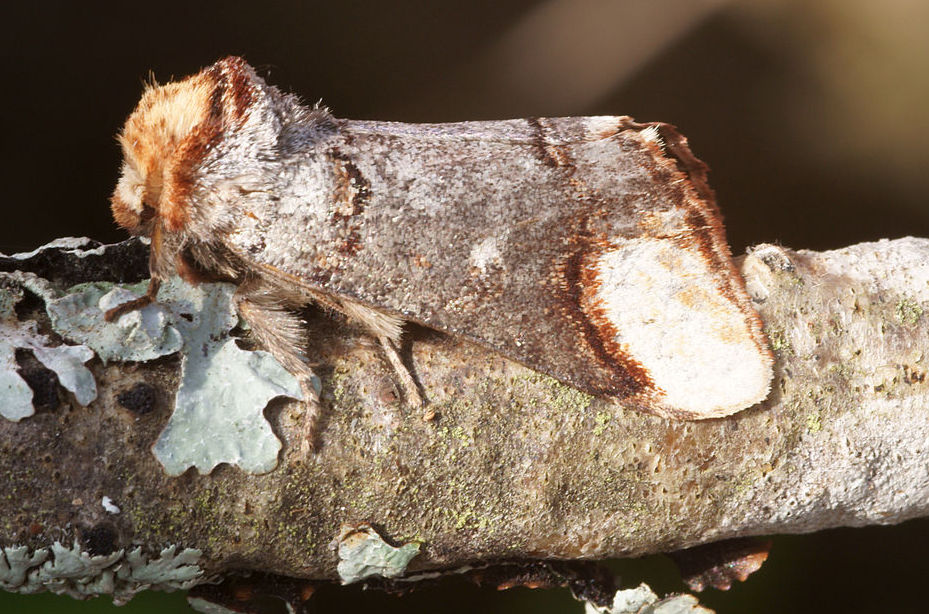

_Common_Pug_(Eupithecia_vulgata)_(3532982809).jpg)
_Common_Pug_(Eupithecia_vulgata)_(3532982809).jpg)
